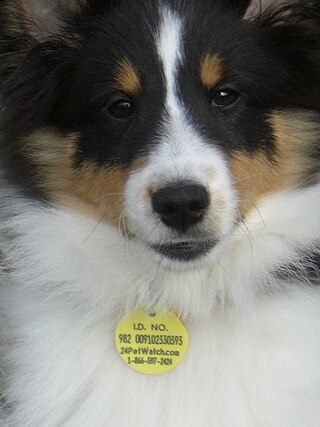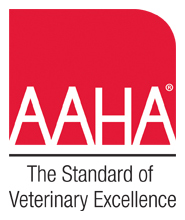
A veterinarian (vet) is a medical professional who practices veterinary medicine. They manage a wide range of health conditions and injuries in non-human animals. Along with this, veterinarians also play a role in animal reproduction, health management, conservation, husbandry and breeding and preventive medicine like nutrition, vaccination and parasitic control as well as biosecurity and zoonotic disease surveillance and prevention.

Pet adoption is the process of transferring responsibility for a pet that was previously owned by another party. Common sources for adoptable pets are animal shelters, rescue groups, or other pet owners. Some organizations give adopters ownership of the pet, while others use a guardianship model wherein the organization retains some control over the animal's future use or care.

The American Veterinary Medical Association (AVMA), founded in 1863, is a not-for-profit association representing more than 99,500 veterinarians in the US.

A microchip implant is an identifying integrated circuit placed under the skin of an animal. The chip, about the size of a large grain of rice, uses passive radio-frequency identification (RFID) technology, and is also known as a PIT tag. Standard pet microchips are typically 11–13 mm long and 2 mm in diameter.
A veterinary specialist is a veterinarian who specializes in a clinical field of veterinary medicine.

Institutional Animal Care and Use Committees (IACUCs) are centrally important in applying laws about animal research in the United States. Similar systems operate in other countries, but generally under different titles; for example, in Canada a typical title would be the University Animal Care Committee (UACC), while in the United Kingdom it would be the Animal Welfare and Ethical Review Body (AWERB).

Veterinary dentistry is the field of dentistry applied to the care of animals. It is the art and science of prevention, diagnosis, and treatment of conditions, diseases, and disorders of the oral cavity, the maxillofacial region, and its associated structures as it relates to animals.

Veterinary education is the tertiary education of veterinarians. To become a veterinarian, one must first complete a degree in veterinary medicine Doctor of Veterinary Medicine.

Vaccination of dogs is the practice of animal vaccination applied to dogs. Programs in this field have contributed both to the health of dogs and to the public health. In countries where routine rabies vaccination of dogs is practiced, for example, rabies in humans is reduced to a very rare event.
Alternative veterinary medicine is the use of alternative medicine in the treatment of animals. Types alternative therapies used for veterinary treatments may include, but are not limited to, acupuncture, herbal medicine, homeopathy, ethnomedicine and chiropractic. The term includes many treatments that do not have enough evidence to support them being a standard method within many veterinary practices.

Veterinary chiropractic, also known as animal chiropractic, is chiropractic for animals – a type of spinal manipulation. Veterinary chiropractors typically treat horses, racing greyhounds, and pets. Veterinary chiropractic is a controversial method due to a lack of evidence as to the efficacy of chiropractic methods. Contrary to traditional medicine, chiropractic therapies are alternative medicine. There is some degree of risk associated with even skilled manipulation in animals as the potential for injury exists with any technique used. The founder of chiropractic, Daniel David Palmer, used the method on animals, partly to challenge claims that the placebo effect was responsible for favorable results in humans. Chiropractic treatment of large animals dates back to the early 1900s. As of 2019, many states in the US provide statutory or regulatory guidelines for the practice of chiropractic and related treatments on animals, generally requiring some form of veterinary involvement.

A pet recovery service is a service that has been created for the specific purpose of reuniting lost or stolen pets with their owners.

A paraveterinary worker is a professional of veterinary medicine who performs procedures autonomously or semi-autonomously, as part of a veterinary assistance system. The job role varies throughout the world, and common titles include veterinary nurse, veterinary technician, and veterinary assistant, and variants with the prefix of "animal health".

The American College of Veterinary Surgeons (ACVS) is the specialty board that defines the standards of surgical excellence for the field of veterinary medicine, promotes advancements in veterinary surgery, and provides the latest in veterinary surgical educational programs. The ACVS is responsible for overseeing the training, examination, and certification of board-certified veterinary surgeons.

Veterinary medicine in the United States is the performance of veterinary medicine in the United States, normally performed by licensed professionals, and subject to provisions of statute law which vary by state. Veterinary medicine is normally led by veterinary physicians, termed veterinarians or vets, but also by paraveterinary workers, such as veterinary technicians, and veterinary assistants. This can be augmented by other paraprofessionals with specific specialties, such as animal physiotherapy or dentistry, and species-relevant roles such as farriers.
A number of studies have demonstrated adverse reactions in pets after administering vaccines to both dogs and cats. Concern about adverse effects has led to revised guidelines that alter the recommended frequency and methods/locations for both vaccination of dogs and feline vaccination.

The Western University College of Veterinary Medicine is a non-profit, private, veterinary medical school at Western University of Health Sciences located in Pomona, in the US state of California. The college consists of about 400 veterinary medical students, and confers the degree Doctor of Veterinary Medicine. The college was established in 1998 as the first veterinary school to open in the country in 20 years. The college is fully accredited by the American Veterinary Medical Association.
The Washington State University College of Veterinary Medicine (CVM) is the veterinary school and one of the ten colleges of Washington State University. Established in 1899, it is the sole veterinary school in the state of Washington and one of the oldest in the United States.
Suzanne Saueressig was the first practicing female veterinarian in Missouri. She was the Humane Society of Missouri's chief of staff for 55 years. She was born in Nuremberg, Germany and graduated from the University of Munich Veterinary College, in 1953. She was the only woman in her class. She came to St. Louis, MO and was hired as a veterinarian for the Humane Society of Missouri. She insisted on raising the standards at her clinic, ensuring surgical instruments were sanitized properly, increasing cleanliness standards for the animals, and insisting on modern x-ray equipment. She was named their chief of staff ten years later in 1965. She is accredited with playing a major role in the Humane Society of Missouri's success. It is one of the largest operating practices in the Midwest today. She campaigned for spaying and neutering animals and had a column in the local newspaper to help educate and improve the local community. In 1972, she claimed the award of "Woman Veterinarian of the Year" by the national organization American Veterinary Medical Association.
The American College of Veterinary Anesthesia and Analgesia (ACVAA) is one of 22 veterinary specialist organizations recognized by the American Veterinary Medical Association.

















